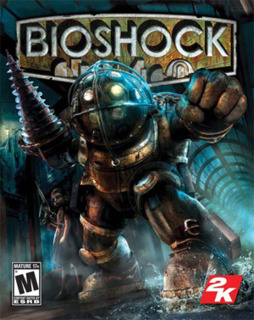INTRO:
After System Shock 2, it had seemed that there would not be another game which could top that classic title’s theme about losing one’s humanity in return for power to do what needs to be done.
Therefore, BioShock was quite the surprise, especially if one considers the fact that the game has been completely overhauled during development to have it depart far, far away from being merely the next System Shock.
Instead of being just a tale of yet another science(-fiction) experiment gone terribly wrong, BioShock is a gripping tale of the consequences of unbridled ambition and freedom.
Most importantly, it has gameplay which ties in very well with its narrative, which was and still is something of a rarity in video games.
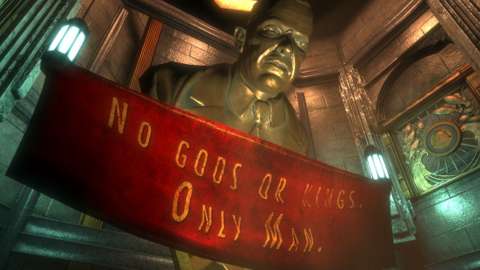
PREMISE:
Even to this day, it would be difficult to describe BioShock’s story without being mindful of dropping a spoiler or two.
Anyway, to players who do not already know the story, it gives a first impression that not all is what it seems. The protagonist appears to be one of the passengers in a plane, which came crashing down near what seems to be a lighthouse. Seeking shelter inside the lighthouse, the protagonist comes across a bathysphere.
In what is not exactly the wisest of decisions, the protagonist decides to take the bathysphere for a ride instead of waiting for rescue. He is brought to the underwater city of Rapture, which according to its founder Andrew Ryan, is a city of unlimited potential for the ingenuity of mankind.
Of course, after having arrived there, that illusion quickly falls apart. The society of Rapture has crumbled and terrible formerly-human things stalk its dilapidated streets. There is also an insurgency which is still going on against an autocrat who appears to be still trying to exert his dominion over what remains of Rapture.
The protagonist will get caught in a deadly intrigue, making decisions which erode or bolster his humanity along the way.
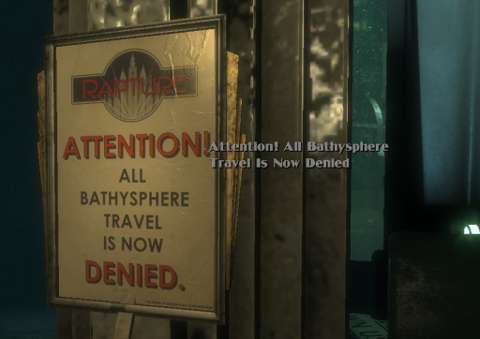
IN-GAME DOCUMENTATION:
Most games would just briefly tell what something does to the player and not do so again later; others that do often do so incessantly, having text come up and clutter the screen or having characters uttering this and that reminder and making noisy nuisances of themselves.
Games which are more user-friendly take a better route instead: in-game documentation which the player can bring up at any time; BioShock happens to do just that.
In addition to tapping a button to bring up the parent menus of the in-game documentation of things in the game, the player can also look at a loose retrievable item for a few seconds and wait for a button prompt to come up. Executing this prompt brings up the documentation entry for this object.
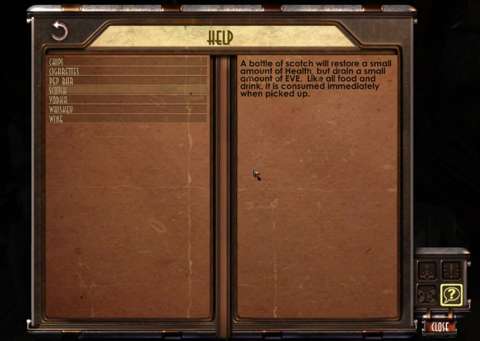
MOVING ABOUT:
The player character can move about in a manner similar to the protagonists in the earlier Shock titles. He can run, walk, crouch-walk or creep. There are toggle-based controls for crouching and running; this is convenient. He can also jump, but the player should not count on this so much; it is a wimpy jump, of the sort which Unreal engine characters have by default.
There are few, if any, other means to move the protagonist about though. Considering that there are enemies which can teleport themselves all over the place, that the player does not get access to such powers is a bit of a lost opportunity.
SHOOTING & RELOADING:
BioShock does not pretend that it is anything other than a shooter. Before starting a playthrough, the player is given the choice of difficulty settings; the descriptions of these settings suggest said lack of pretense.
Shortly after obtaining the typical fallback melee weapon often seen in shooters before BioShock’s time, the player comes across the first gun in the game.
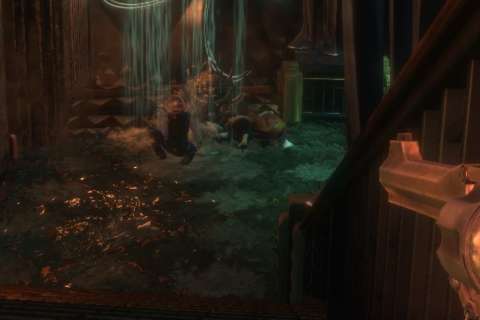
Shooting is mainly a simple affair, at least for veterans of shooters. The player has to learn about the idiosyncrasies of each weapon, e.g. their spread, damage fall-off and shot scatter, and then deploy whichever weapon is most useful for a situation. This is nothing that a veteran of shooter titles would not know already, of course.
The game does remember the state of the magazine of any weapon which the player is using, so the player might want to consider reloading weapons to full whenever possible. Having magazines run empty during combat is not pleasant.
With that said, mere shooting is not always the player’s most effective or efficient method of dealing with enemies. This is deliberately so, because the player will have to use other means to do well in battle.
USING PLASMIDS:
The protagonist will not be merely using guns. He will gain and use superhuman powers too.
This is made possible through the primary plot element of “Adam”, the genetic material which certain industries in Rapture produces and which is partially responsible for the collapse of Rapture. Anyway, the aforementioned superhuman powers, called “Plasmids”, are one of the products of the ADAM industry.
Taking these into the body grants powers as described by their marketing labels. Afterwards, the protagonist can use these powers in lieu of weapons, but never both at the same time.
Even with this limitation though, switching back and forth between them is easy – as long as the player keeps the protagonist’s current EVE reserves and weapon magazines in mind. Having to reload weapons when switching to them and having to use an EVE hypo (more on this later) is not fun.
Also, the observant player might notice that as long as the player has some EVE left (more on EVE later), even a little, he/she can still use any Plasmid before having to recharge with a hypo.
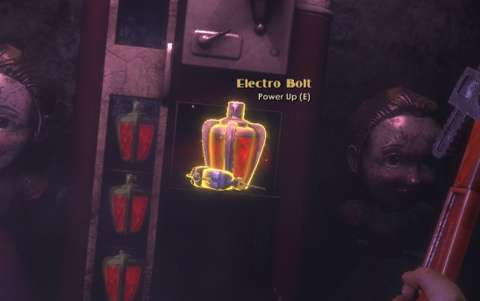
The variety of plasmids will be described further later in their own section.
HEALTH & EVE:
There are conspicuous bars at the top left of the screen, showing how much health and “EVE” which the player character has left. The bars start quite short, but there are opportunities to increase their lengths.
Health should be self-explanatory. “EVE” may have a peculiar name, but it is practically a mana-like resource. The mana that is EVE powers the “spells” which are the Plasmids. In BioShock’s narrative, EVE is the other organic material besides ADAM, albeit EVE can be generated within an augmented human’s body.
Both gameplay elements are serviceable, if unremarkable.
USING EVE HYPOS:
Using first aid kits to restore health is an instantaneous action, for whatever reason. Still, this convenience is welcome, especially during battles.
However, EVE hypos are not as easy to use; there is an animation of a few seconds in length which the player must endure.
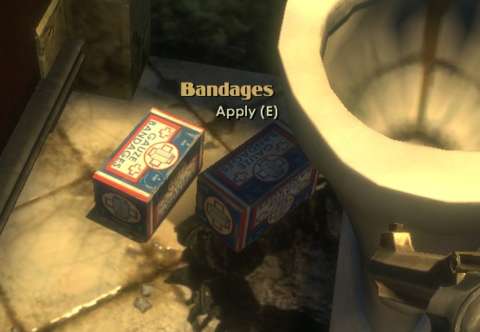
Perhaps this was intended to make Plasmids balanced against weapons, but the contrast between first aid kits and EVE hypos is just too noticeable.
Still, observant players might also realize that the animation can be canceled by switching weapons or plasmids.
GOBBLING STUFF:
The protagonist has the gameplay trope of heroes with absurd metabolisms. He can eat edibles and drink beverages, or otherwise consume sundries, to restore his health and EVE.
However, as much as this gameplay element of consuming things to regain health and other resources is a trope, it does make down-times between fights more meaningful. The wise player would be looking around for food to scarf down in order to juggle the meters.
Not all consumables provide purely benefits; some take away health and give EVE, and vice versa. However, they still provide a net gain in either, if one is to measure the amounts gained or removed.
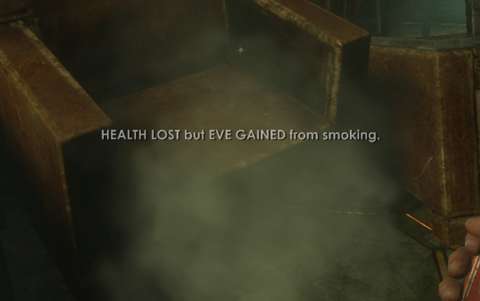
SCAVENGING:
The player character will be rummaging through a lot of containers and corpses; scavenging is essential to survival.
Therefore, it is fortunate that the act of searching through junk has been simplified to just bringing up a list of icons when the player looks into a container or a corpse. With mere taps of the “use” button, the player character can loot something clean quite quickly, if the player character still has room in his big pockets.
However, it would appear that there is no way to pick which item in a container or corpse to loot before the others, if a container has more than one item to loot. By default, the player character will always attempt to loot the uppermost item first, and then automatically attempt to loot the rest, if able.
This can be a problem if there are items which the player does not want at the top, such as food items which are not needed when the player character is at full health.
(Incidentally, there appears to be built-in but unimplemented control inputs to select loot for retrieval, as implied in this Steam forum thread.)
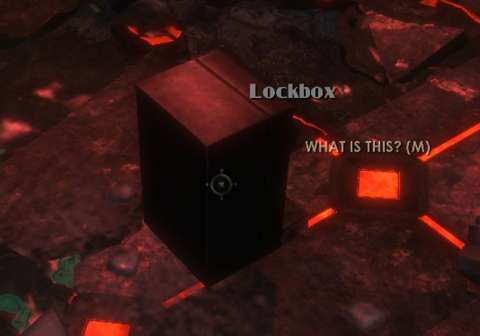
DIFFICULTY SETTINGS:
As mentioned earlier, the player has to pick a difficulty setting at the start of any playthrough. The difficulty setting involves the usual tropes about difficulties, such as the ratio of the damage which the player character can inflict against the damage which enemies can take before they expire.
The settings also happen to influence how much loot the player can expect to scavenge off corpses and containers, with the exception of rare containers such as safes and out-of-the-way supply caches.
To players who are already experienced at both shooter titles and who are used to resource-juggling gameplay, BioShock would seem too easy. Even “Hard” with gameplay crutches turned off would seem nothing more like a familiar challenge.
GAMEPLAY CRUTCHES:
A gameplay option which makes a more substantial difference to gameplay is the Vita-Chamber. In the narrative of BioShock, the arcane machinery known as Vita-Chambers are reserved for the particularly privileged in Rapture. There is a narrative reason for the protagonist being able to somehow use these. Yet, even with this reason, its benefit can seem contrived.
This is because the Vita-Chambers simply resurrect the player character when he dies; the conditions of the current level and the enemies in it are retained. This means that the player can resort to attrition in order to whittle down enemies, especially Big Daddies who are guarding Little Sisters (more on these later).
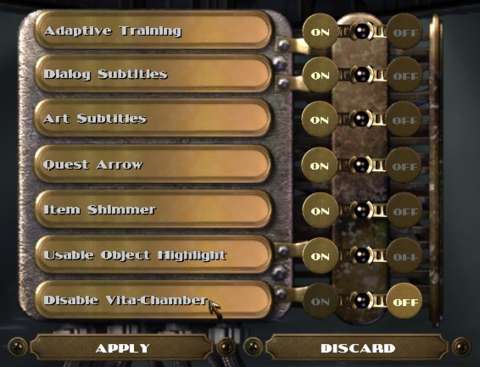
MAP SYSTEM & EXPLORATION:
Exploring Rapture is key to the gameplay. The player is told where to go via a vague arrow indicator which points in the direction where the player character needs to go in order to progress in the game, but it is the player’s interest to go off the beaten path.
The map system is of particular importance to exploration; it seems to be mainly there for this purpose. Somehow, when the player character enters a level for the first time, he gets a map for it; perhaps the service radio which he obtained early in the game has the maps, but even with this, this can still seem rather convenient.
Nevertheless, the maps are useful enough for the player to figure out where to go next. Interestingly, the layout of the level is always presented in the same screen; translucent red arrows and stair icons indicate the connections between floors. This might take a while for players who are used to more restrictive user interfaces to learn, but this kind of presentation is a lot more convenient.
Anyway, the map of any level starts with greyed-out rooms and regions. These are coloured a light beige when the player enters them for the first time. Rooms which have been coloured also have icons which depict stations and vending machines that the player can use.
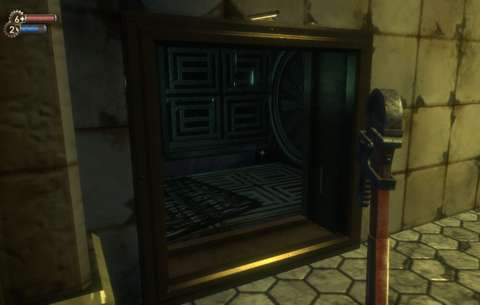
However, there is a minor complaint here: which room or region is coloured in is dependent on the doors and boundaries which it has, and not the actual proportion of the room or region which the player has explored.
As an elaborative example, the player might have just entered a large room, chamber or tunnel network which has no doors partitioning them, and the map system will colour in the entire place as if it has been explored.
This can be troublesome to players who depend on the map system to gauge how much of a level which he/she has explored.
LOOKING INTO NOOKS AND CRANNIES:
Due to the current state of Rapture, many rooms and corridors which appear in the maps are blocked off. However, there are always ways to go around the obstacles into these places. The player will need to be both observant and curious though.
Just about anything in Rapture is indestructible; this is to be expected of a game world which is created with the Unreal engine. However, there are a few things which can be destroyed, such as grates on vents. This may be obvious to experienced players, but others would have to learn this through hitting things with the wrench or shooting them.
The lessons on exploration which are more fun to learn are those which concern Plasmids. Early on in a playthrough, the player will come across the Incinerate Plasmid. As its name suggests, it sets things on fire; the player will not be told of what it can exactly do though. Rather, the player has to keep in mind that fire heats things up, the implications of which would become apparent if the player exercises some pyromaniac tendencies.
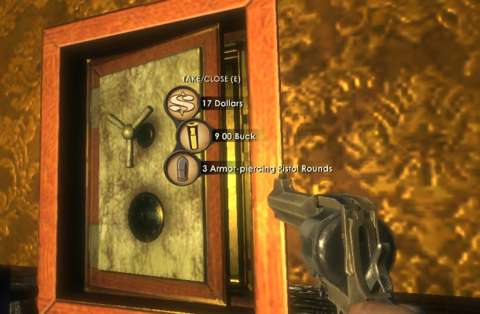
Eventually, a skilled and observant player would be able to notice the signs of where there are hidden caches of supplies. Yet, even to seasoned players who may have had multiple playthroughs with the game, remembering where all the goodies are can be quite difficult.
MONEY AND VENDING MACHINES:
Rapture may no longer be a civilized place, but money still has value in it. This interesting contradiction is made possible through the convenience of Rapture’s vending machines.
Money is scattered all over Rapture, and can often be found on the corpses of enemies too. The player can gather a lot of money, but only up to 500 dollars (despite what the counter’s four-digit capacity would suggest).
Narrative-wise, it is not clear whether the vending machines are merely stocking items or are actually capable of fabricating items on the spot. In either case, they can only be operated by chucking money into them, so Rapture’s dollars are still useful if one is looking for re-supplies.
Not all vending machines are useful. For example, the Swami fortune-telling machine is useless; this may or may not be a message by the game developers.
Some others appear to use money, but does not deduct the player’s reserves, such as the music-changing jukebox.
Some vending machines can be “hacked” for additional benefits. There will be more on “hacking” later.
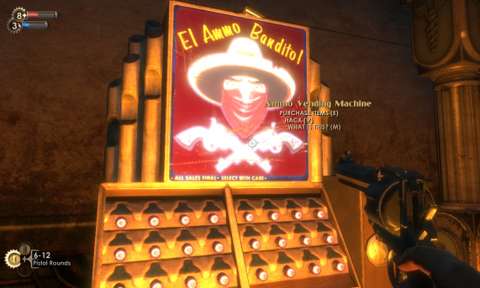
SLOT MACHINES:
Slot machines get a mention of their own section in this review – though not in praise of them.
As to be expected of slot machines, they are means of gambling. The player may lose or gain money from playing them, depending on the fickle RNG scripts on which they are operated.
However, with the feature to save and reload games, losing is not an issue. An unscrupulous and stubborn player can exploit the slot machines so that they pay out, and from here on, supplies of ‘regular’ items are no longer an issue. This can ruin the game’s emphasis of careful resource management, especially on the “Hard” difficulty setting.
Of course, it can still be argued that it is up to the player on whether to exploit this minor gameplay element or not. After all, prudent players will find themselves having more money than they need.
DESTRUCTIBILITY OF FIRST-AID STATIONS:
Most machines in Rapture are indestructible objects, but first-aid stations are not. There are reasons for this disparity.
The foremost reason is that they do cost money to use; obviously, if the player has no money, he/she cannot use them to heal the player character. However, there is a work-around if he/she has no money and is desperate: the player can still choose to wreck the stations to have them release some first-aid kits.
However, this, of course, renders them unusable; it also suggests that the player is careless and not skilled enough to manage the player character’s health.
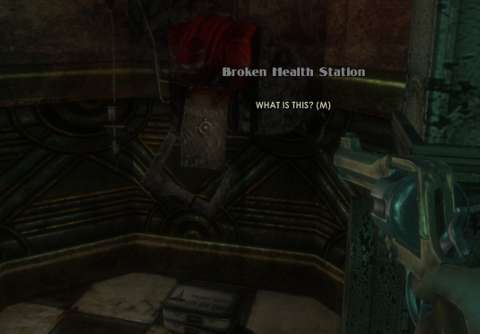
The other reason is that splicers can use them. Of all the machines in Rapture, first-aid stations are the only ones which they interact with, apparently in order to heal. Some players may be tempted to shoot first-aid stations before they reach them, but it is probably better to just continue shooting at the splicers instead.
To some players, having a first-aid station being destroyed by stray gunfire or explosions can be aggravating. To them, the destructibility of first-aid stations would seem like a counter-productive game design.
HACKING MINI-GAME:
Early in the game, the player is given the opportunity to learn the element of “hacking”. Some machines can be “hacked” to grant benefits.
This early opportunity is not exactly clear though. The game drops some hints here and there, but only observant and curious players will quickly know of this opportunity (assuming that they are not perusing guides). This is because at the default settings, the tooltip for “hackable” objects do not appear immediately when the player looks at them.
Anyway, once the player has learned that some machines can be “hacked”, he/she would learn that “hacking’ is a mini-game of sorts – specifically a mini-game with gameplay seen in the likes of Pipe Mania.
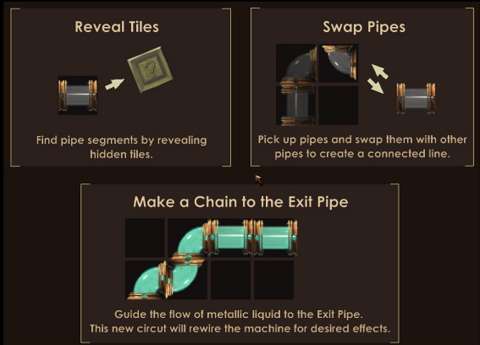
To elaborate, the player must connect what appears to be pipe sections together in order for some kind of fluid to flow through them. These sections must connect the starting node to the exit node, while avoiding hazards like overload tiles and alarm tiles.
The player cannot abort a mini-game. If the player attempts to quit before completing the connections, the fluid flows to the end of the connected sections anyway, thus immediately failing the mini-game.
According to BioShock lore, this is presumably to bypass some of the functions in “hackable” machines. In terms of gameplay though, the player is merely playing a game of getting something from point A to point B by placing paths in its way.
The world of Rapture is frozen in time when the player plays a hacking mini-game, but that does not mean that there is no sense of urgency. The fluid will start pumping on its own, so the player might want to connect paths to avoid it from reaching a dead end.
HACKING BENEFITS:
At least the hassle of doing the mini-game rewards the player with considerable advantages. These advantages are always told to the player at the start of the hacking mini-game, and they differ from machine to machine.
For example, ‘Circus of Values’ vending machines can be hacked to give cheaper prices on its goods. As another example, the crafting machines can be hacked so that they become more efficient (which suggests that the player is repairing them instead of circumventing their functions, but that is another matter).
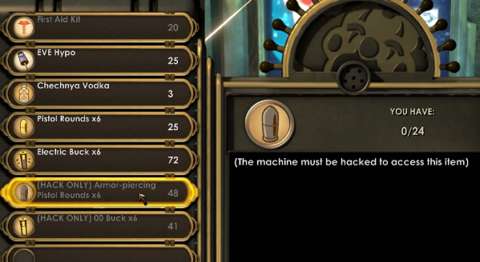
Then, there are more hilarious benefits. For example, hacking a first-aid machine makes its services cheaper (and noticeably more economically efficient than any other purchasable option of healing). Moreover, it also kills any splicers who are using them to heal.
Security machines can also hacked to grant the player some means of dealing with respawning enemies in a level. They are a lot riskier to approach and hack though.
Perhaps there was a lost opportunity to grant the player further hacking options, such as choosing what a hacked machine would do afterwards. However, what BioShock had done was, back in 2007, already quite sophisticated.
(It can be even said that the game, together with contemporaries like Mass Effect, started a trend of “hacking” mini-games, for better or worse.)
HACKING DIFFICULTY:
Before starting a hacking mini-game, the player is shown its relative difficulty. “Easy” ones give the player plenty of room to work with, though more tiles have to be uncovered (which can seem tedious). More difficult ones have less room, and more overload and alarm tiles which get in the way. Indeed, if the player is not fast enough, he/she would not be able to divert the fluid in time to avoid a dead-end.
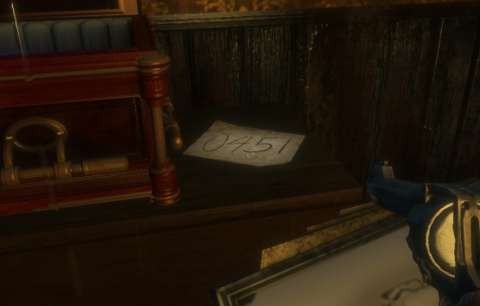
BYPASSING HACKING:
Apparently, BioShock’s designers are aware that not everyone would like the ‘hacking’ mini-game. Thus, there are a few means to bypass it.
There are items which can completely bypass the mini-game, though the player can only have a handful of these. Even without these, the player can choose to spend money to somehow do a bypass, though the costs are proportional to the difficulty of the mini-game.
Completing the “research” of some security machines also grants automatic success to any attempts to hack them. Finally, there are also codes to find which can be input into locks to release them.
THE WRENCH:
The wrench is the first ‘weapon’ which the player gets, albeit an improvised one. Heavy-duty tools being used as weapons in video games is nothing new. It is also a typical fall-back weapon, when the player runs out of ammunition (usually due to carelessness and/or incompetence).
However, there are some options to be had if the player wants to play through BioShock with the wrench. There are some tonics which increase the damage of the wrench, among other things like somehow granting it life-stealing properties. Playthroughs done mostly with the wrench are indeed viable.
However, the fact remains that the Wrench is just a bludgeoning tool throughout the game, regardless of how the player approaches combat. There are lost opportunities to make it more useful and versatile.
(ACTUAL) WEAPONS:
As mentioned earlier, shooting is a major part of the gameplay in BioShock. For that end, there are quite a number of guns to use, and the player character is conveniently a walking armory.
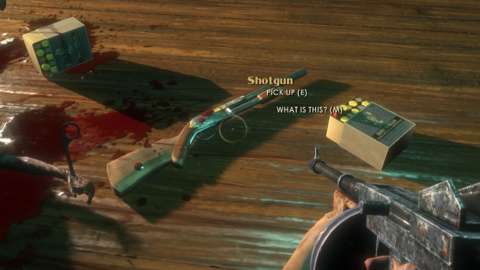
Every gun has its own niche. For example, the Revolver is one of the most accurate weapons at distances of up to two dozen feet. Its damage-per-shot rating and fire rate also makes it suitable for engagements at these ranges. Players who are veterans of shooters would quickly realize the niche of any weapon.
There had been opinionated complaints by some quarters that the weapons just do not feel ‘satisfactory’. Indeed, if the player has come from games like Unreal Tournament, the weapons in BioShock are certainly underwhelming in comparison.
However, BioShock’s guns are best compared with those in a more comparable game such as Deus Ex, which has overall gameplay that is similar to BioShock’s, and certainly more so than a ‘hardcore’ shooter franchise like Unreal.
DIFFERENT AMMUNITION TYPES:
Each gun has its own set of ammunition, e.g. there is more than one type of ammo for each gun.
There is regular ammunition, which are named according to its associated gun. This is the most common ammo and can almost always be bought from vending machines, if the player has found their associated guns. The player character also has the most pocket space for this ammo.
The other types of ammo are rarer and the storage capacities for them are lower. Most of them are ammo which is specialized towards killing specific targets. For example, there are Anti-Personnel Rounds for the Machinegun; these are more effective against splicers than other machinegun ammo.
Some are more interesting though. For example, the Grenade Launcher can set proximity mines, which are handy for preventing attacks from behind.
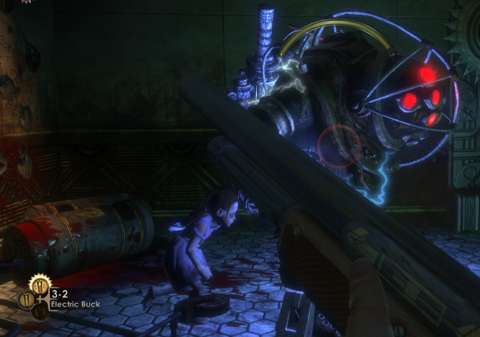
The more special ammo types can be found in supply caches, bought from hacked vending machines or fabricated at U-Invent stations.
WEAPON UPGRADES:
Most of the weapons appear to be based on real-world ones. However, there is a gameplay element in BioShock which will turn them into outrageously customized versions of themselves.
Throughout Rapture, there are several workbenches with machines which can perform ‘enhancements’ on guns. They are often out of the way, and sometimes hidden in unlikely places, for whatever (narrative) reason.
There are not enough stations to upgrade all weapons to their fullest potential, so the player might want to consider his/her choices carefully – or just upgrade weapons which cater to their playstyles.
Anyway, these upgrades usually grant improvements to the weapons, though whether they would not be pleasing to gun enthusiasts or not is another matter. For example, the Shotgun’s appalling initial magazine capacity can be upgraded, but the shotgun now sports some unsightly attachments.
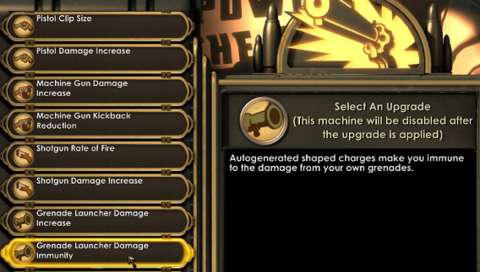
ADAM:
Within the story, ADAM is the most sought-after resource in Rapture. With regards to the gameplay, the player will want it too.
It is interesting to note here that ADAM is never depicted directly in the game. The closest there is to a depiction is the gore and blood which Little Sisters extract with their syringes and consume afterwards, supposedly to recycle ADAM.
Speaking of whom, Little Sisters are the main source of ADAM. They are not easy to get to though; this is because of their guardians, who will be described later.
PLASMIDS:
Plasmids are usually obtained by buying them with ADAM at the Gatherer’s Garden – functional machines of which are only found some time into a playthrough.
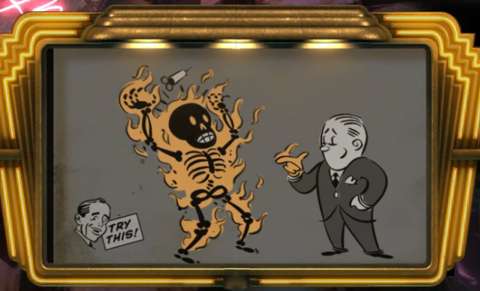
Oddly enough, Plasmids cannot be equipped like weapons. The protagonist may be a walking armory, but he can only support the equipping of several Plasmids at a time. Initially, he can only have two equipped, but the player can open more slots by spending ADAM.
Just about every Plasmid has non-combat utility. For example, the first Plasmid, Electric Shock, can jolt enemies, as well as exposed control panels (these are marked by sparks which they emit, and appear only to be around for this purpose). As another example, Incinerate can be used to free frozen-over rooms, and from afar too (something which the Flamethrower cannot achieve).
Perhaps the most entertaining Plasmid is Telekinesis. Of course, this is practically the “Gravity Gun” of BioShock, to make a reference to Half-Life 2, which started the trend of physics-manipulating guns in the shooter genre.
If there is a significant problem with the Plasmids, it is that the player is not shown exactly how much EVE a Plasmid would consume when it is used. Considering that guns do have predictable consumption rates, that Plasmids do not can give the impression that Plasmids are not as reliable as guns are in combat – this is not an entirely correct impression, of course.
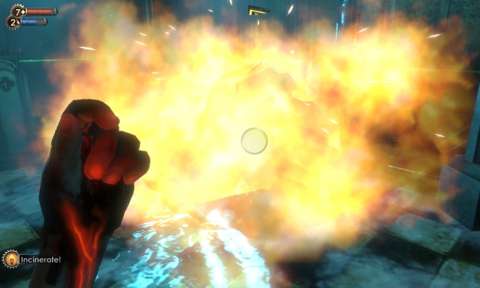
TONICS:
Tonics are “gear” which the player character can equip in order to obtain benefits which contribute to the gameplay elements which have been mentioned earlier in this review. Consequently, they are rare.
They are given as rewards for particularly meticulous exploration. Some tonics can also be bought with money (or sometimes ADAM), or obtained as results of “research” (more on this later).
Initially, the player can only equip a few tonics. Later, the player can unlock more slots – again by spending ADAM.
Tonics are also categorized into three categories: Engineering, Combat and Physical. Combat and Physical tonics are closely related, though Combat is obviously more offense-oriented whereas Physical tonics provide dual-use benefits. Engineering tonics are more related to non-combat matters, such as hacking and crafting.
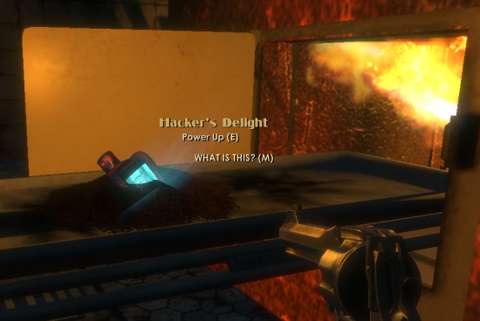
If there is an issue about tonics, it is that the player needs to use gene banks in order to switch them around. This can seem bothersome, but it does contribute to the notion that these tonics are not physical gear so this is a minor complaint.
GATHERER’S GARDEN U.I. PROBLEM:
Most of the Plasmids and Tonics which the player would use are bought with ADAM at the Gatherer’s Garden, together with health and EVE capacity upgrades. Unfortunately, there are a few minor problems with the user interface which remains to this day.
When the player is shown the selection on “sale”, the listing does not inform the player which entry is a plasmid or tonic; only the health and EVE upgrades are immediately obvious.
This can confuse the new player. As an elaborative example, an inexperienced player might buy a plasmid, thinking that it is a tonic. (Observant players might notice that plasmids have words in capital in their descriptions, of course.)
The player character’s slots for tonics and plasmids are also not shown, so the player will need to manually look at the slots before browsing the Garden’s wares.
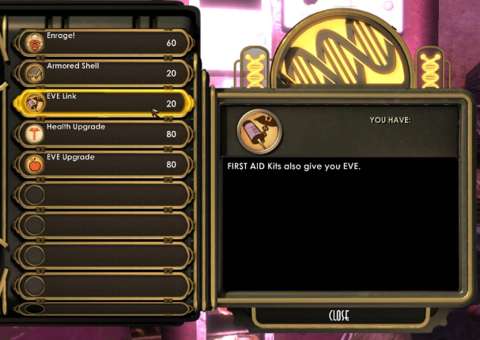
At the very least, all Gatherer’s Garden outlets show the same choices, which are expanded as the story progresses.
DOWNLOADED CONTENT:
Firstly, it has to be mentioned here that BioShock does not have priced DLC, but it has signs that 2K Games is about to take this business route in its later games.
BioShock’s first patch was implemented in-game like it is downloadable content. It brought with it additional tonics and plasmids. The level one variants of these are available to the player at just 1 ADAM each, presumably to allow the player to quickly peruse them.
Some of them can be potent, such as a tonic which provides discounts at vending machines. They can seem overpowered, but this is sort of balanced later by the substantial costs of their more powerful versions.
“RESEARCH”:
BioShock may be a shooter, but this did not stop the developer from trying to cram more gameplay elements into it, even if these elements might seem out of place. “Research” is one of these.
A couple of chapters into a playthrough, the player character is directed to locate a research device with capabilities which can seem absurd.
The “research camera” is this device, and it appears to be capable of making analyses using just images of “research subjects”, i.e. any security machine, Splicer, Little Sister and Big Daddies which is caught on the camera. To make it seem even more odd, the Research Camera is equipped like a weapon.
In video/computer games, “research” is little more than just pouring resources into unlocking a pre-designed benefit or option for the player, e.g. what passes as “research” in real-time strategy games.
In BioShock, the player has to spend resources too, namely film.
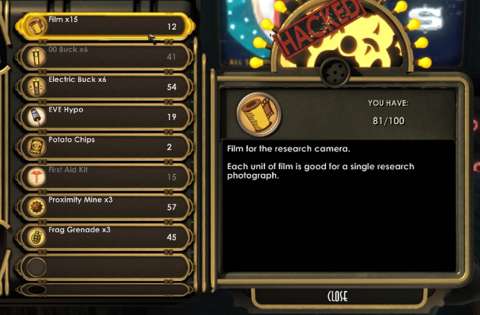
However, the player must actively put in some effort too. This effort involves taking photos of the aforementioned research subjects. The photos yield progress towards the research of the associated subjects.
The amount of progress obtained by a photo is determined by several factors. The first and foremost factor is how much of the subject’s silhouette is in the photo.
To elaborate, if its silhouette is obscured, the output is diminished. If the subject is too close and thus parts of its silhouette is out of the photo, the output is also reduced. If the subject is too far away and thus its silhouette is just a small part of the photo, the output is also diminished.
Then, there are other factors, most of which are quite understandable, though not necessarily well-implemented.
If the photo subject has been photographed already, the output is reduced. This is intended to encourage the player to seek out other photo subjects of the same sort. However, it is up to the player to remember which creature or machine has been photographed already; the game will not do this for the player, though it keeps a checklist which is hidden from the player’s eyes.
If the photo subject is on alert, the output is greatly improved; obviously, a subject on alert is more dangerous than one idling away or roaming around with little care. This is an effective risk-versus-reward game design.
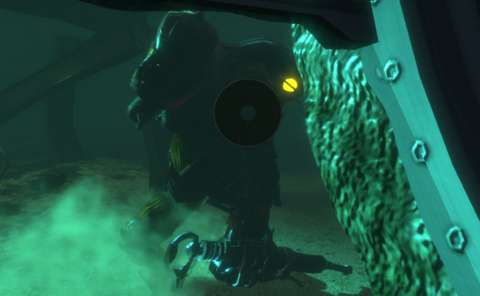
If the photo subject is already dead, the output is greatly diminished. Nonetheless, this means that the player can still photograph Splicers or machines which have been killed in fights which the player did not start.
The most nuanced yet most disappointing factor is having multiple photo subjects in the same photo; this grants a substantial progress bonus. However, the progress which is obtained only goes towards the research of the most prominent subject in the image. As for the other image subjects, they are counted as already photographed.
This means that later attempts to photograph them specifically for research into them yields less progress, which can be irritating.
On the other hand, if the player has already finished research into some types of subjects, getting them into the photo contributes towards progress into another subject which has yet to be fully researched.
A strip of film is spent whenever the research camera takes a photo which grants significant progress (the threshold for what is considered “significant” is not clear). Conveniently though, if the photo will not yield significant progress, the film is not consumed.
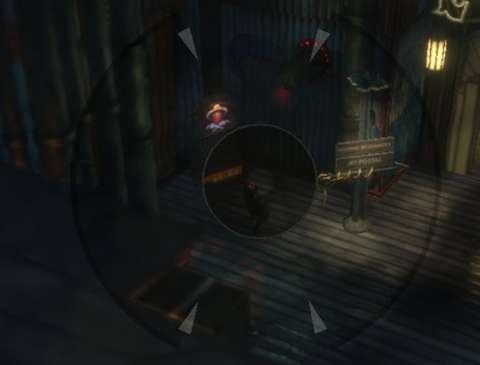
As for the benefits of “research”, they are technically a form of a progression system, i.e. a system to improve the player character’s capabilities which are within the player’s control. Some tonics and plasmids are exclusively rewards from research. Most importantly, the player can gain damage bonuses against enemies; this will matter a lot when enemies start to become tougher.
Jaded cynics will point out that the gameplay designs of the research camera have been done before, such as in the Fatal Frame franchise (which debuted in 2001) and (arguably) the first Dead Rising (which debuted in 2006 – close to a year before BioShock). Therefore, there can be the argument that BioShock has not done anything new with its “research” mechanic.
However, although these assertions are true, it is still, even to this day, rarely implemented in shooter titles as a progression system.
U-INVENT & “CRAFTING”:
Much later into the game – starting from Arcadia onwards – the player comes across seemingly useless items such as empty hypos and rubber tubes. These are actually used at U-Invent machines, which cobble these knick-knacks together into something useful.
The game passes this off as the gameplay mechanic of “crafting”. In practice though, crafting materials are just another form of currency, specifically currency which can only be spent at U-Invent machines. If they have any more sophistication, it is that a mix of crafting materials is needed to ‘purchase’ any option at the machines.
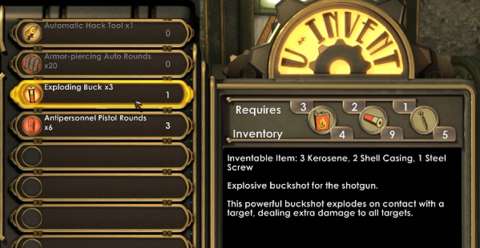
Perhaps this gameplay element could have been convincingly more about crafting if there is some other factor involved. However, since the main purpose of crafting is to provide the player with goods through means other than looting or purchases from vending machines, it could not be any more sophisticated.
BATHYSPHERE SYSTEM:
After having the aforementioned gameplay elements introduced to the player, the game presents the last major gameplay element: the bathysphere system. This essentially allows the player to return to almost any previously travelled-through place in Rapture.
(As hinted at in an earlier screenshot, bathysphere travel is denied to all but privileged persons. How an outsider like the protagonist can use it is only revealed if the player can connect the narrative dots.)
Anyway, the bathysphere system is mainly there to give the player a chance to grab anything which he/she has missed. More skillful and thorough players would be able to get everything in a level the first time around.
ENEMIES – OVERVIEW:
Most of the enemies which the player would face are formerly human, now insane beyond help. All of them also happen to heavily “spliced”, to use the in-universe term for having been mutated with ADAM-based products.
Other enemies include the fearsome Big Daddies, who always guard the Little Sisters. The player must fight them in order to get opportunities to obtain ADAM.
There are also the automated security apparatus of Rapture to deal with, though if the player is wise, he/she would attempt to hack them and turn them to his/her side permanently.
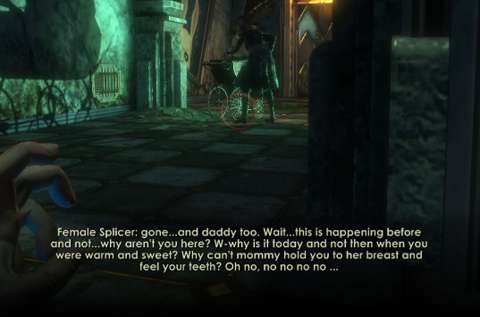
Enemies are not just mere threats to the player; every type has some nuances, in terms of narrative and/or gameplay. These will be described in the following sections.
SPLICERS:
The “Splicers” are the name given to the (formerly) people of Rapture who have become addicted to the body- and mind-altering ADAM-based products. They have become disfigured, hostile (even to each other) and very aggressive.
Usually, they are wondering around looking for things; a few appear in set-pieces, uttering bits and pieces about the backstory of Rapture and its fall. They generally ignore each other, but in some cases – usually pre-scripted – they attack each other. Such scenes can be seen in the Medical Pavillion, where angry former customers of the mad cosmetic surgeons there – who are also Splicers - will attack the latter wherever they meet.
Eventually, the player will be introduced to nastier Splicers, other than the Leadheads and Thugs which the player face at the start of the playthrough.
These more powerful splicers are apparently hostile to the lowlier ones. These nastier splicers are actually the upper-class of Rapture, and they are not happy that the lowlier splicers are encroaching upon what they see as their domain. BioShock could be making a message about class warfare in this regard.
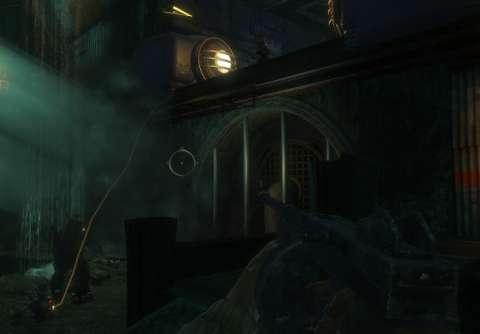
SECURITY APPARATUS:
In his attempts to secure Rapture against those that would take it away from him, Andrew Ryan has turned the security apparatus against those who oppose him. That includes the player character.
Upon detecting the player character, the player has only a second or two to react before they start performing functions, all of which bring harm to the player character. Turrets start shooting, cameras begin the procedures to trip alarms and if there are drones around, they search and destroy.
Turrets are particularly tricky because they can be armed with machineguns, rockets, or flamethrowers. It can be hard to see which armament they have without being up close.
Security machines tend to be very difficult to destroy, mainly because they are considered as “armoured”. This makes them inefficient to damage with regular ammo, requiring the use of precious armor-piercing rounds (which are better off used against Big Daddies).
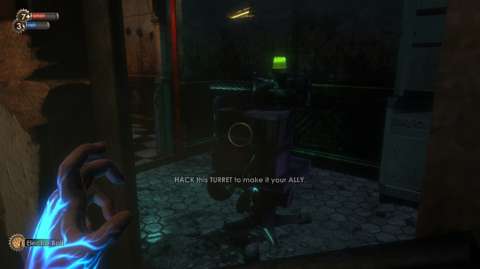
Fortunately, all of them are vulnerable to electrocution. In addition to doing considerable damage (or at least more damage than almost any other means would), electrocution shuts them down, thus making them vulnerable to hacking.
The player can also hack them If the player can approach them without alerting them. Such is the case for security cameras, which have blind spots underneath them, and for security cameras, which cannot detect anything in their rear arc.
Hacking security machines turns them to the player’s side. Since hacking pauses in-game time too, there is very little risk to hacking; the legwork is mainly about shutting them down or creeping up onto them.
Getting some types of security machines on the player’s side is desirable, but the others, namely the mobile ones, are not very reliable allies. This will be elaborated further later.
BIG DADDIES:
Big Daddies are built to be the heavy-duty labourers of Rapture, but they are also very capable at combat too. Their lumbering demeanor also belies their incredibly speed when they are enraged.
In combat, Big Daddies are not much different from other examples of the “bruiser” archetype of enemies which are so pervasive in video games. They are tough to kill, have few vulnerabilities and can inflict incredible amounts of damage if the player is not careful.
There are two types of Big Daddies, both of which are sub-types of “bruisers” (and both of which are “poster boys” for BioShock). The Bouncer is the one with the giant heavy-duty drill and is of the “lightning bruiser” sub-type. Despite his looks, he is incredibly fast at running things down.
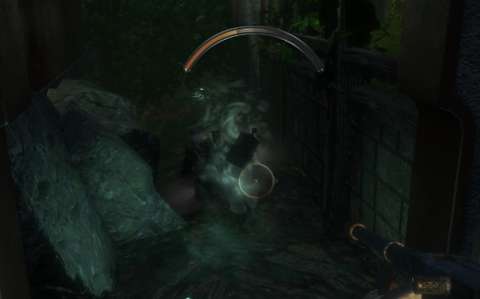
Then there is the Rosie, which has a large nailgun and quite a lot of explosives to toss around; he is of the “heavy weapons bruiser” subtype. He is a lot slower than the Bouncer, but with the firepower which he has, he does not need to move much.
What is refreshing about them is their role in the story, and the ADAM-gathering gameplay element which is associated with them. They are the guardians of the Little Sisters, who, since the fall of Rapture, have become a lot more vulnerable.
Indeed, if the player shadows a Big Daddy and his Little Sister around long enough, he/she may find Splicers either deliberately avoiding the two, or actually attacking them (usually through scripted events). This ends poorly for the Splicers, of course.
With that said, it is not very often that hulking brutes are portrayed as devoted protectors in video games, even at this time of writing.
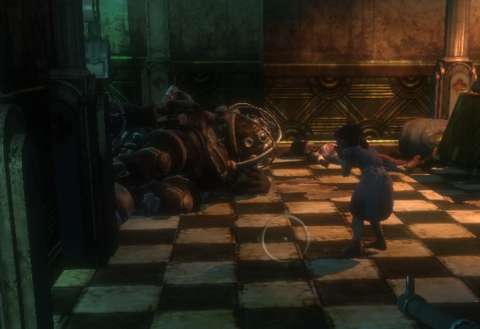
LITTLE SISTERS:
A Big Daddy tends to carry a lot of money on his person, for whatever reason, but the main reward for having defeated a Big Daddy is the Little Sister he was guarding.
The player’s first encounter with the Little Sisters poses a choice to the player: “harvest” the Little Sister’s ADAM-producing symbiote, which will kill her, or “rescue” her, in which case the mental conditioning and some of the powers of the Little Sister are removed. Either way, the player gets some ADAM to spend – more if the player took the lethal (to her) option.
Every Little Sister afterwards poses the same choice. The game uses tallies of the player’s decisions to determine which of the three endings which the player would get.

BOSSES:
Most of the enemies in BioShock have significant backstory and variety. Yet, this makes what pass as “bosses” in this game all the more disappointing.
With the exception of the final boss in the game, boss enemies are practically stat-boosted variants of enemies which the player has come across prior to the encounters with them.
For example, Dr. Steinmann – a particularly deranged cosmetic surgeon – is a splicer who alternates between the Nitro Splicer and the Leadhead Splicer. Tactics which work against these Splicers work against him too.
They are characters who have significant presence in the story, so the fact that their combat capabilities are recycled from regular enemies can seem underwhelming.
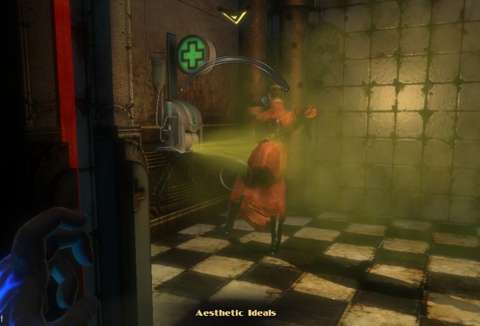
SIGHT RANGE & PURSUIT:
Living enemies cannot look very far. This can be explained by the poor lighting in Rapture.
It will take a while for Splicers who are looking in the player character’s direction to spot him, even on “Hard” difficulty. Shooting them, of course, puts them on alert right away. Security turrets, on the other hand, can see uncomfortably far.
After living enemies have detected the player character, they are not easy to shake off. Spider and Houdini Splicers, in particular, are very capable at pursuits, though Leadheads and Thugs can be lost if the player can turn around enough corners out of their sight.
In some levels, especially those with a lot of routes which go to the same location and those with side paths, enemies have additional scripts which allow them to make use of these paths to flank the player character with. This can be unpleasant to learn if the player had been too complacent.
THROWN OBJECTS & DETECTION:
There may be an exploit involving objects which are thrown using Telekinesis. Enemies which are hit with thrown objects may not always realize that the player is hurting them; this is likely because the scripts which alert them to the presence of their attackers make use of damage from shots, and not damage which is inflicted using Unreal engine physics. The most which happens is that they would be alarmed and start looking around for their assailant.
This can be used most effectively against Big Daddies. If the player can prepare a stockpile of fuel barrels and canisters close to the patrol paths of a Big Daddy and at where the player can angle long-range throws at him, the Big Daddy can be severely damaged before the player delivers the killing blow.

ALLIES:
The player does not always have to be alone when fighting. The player can get some “friends” to help. These “allies” are typically hacked security machines or hypnotized Big Daddies (if the player picked the “rescue” route and stuck to it).
Security turrets and security cameras are especially convenient allies; they can hold down corridors or rooms against respawning Splicers. For example, if the player listens closely, he/she might hear turrets shooting Splicers while the player character is away in another floor, or security cameras summoning in drones to attack encroaching Splicers.
Speaking of drones, these are not the kind of allies which the player might want. Sure, flying robotic pals with machineguns might seem useful, but they have major problems in their path-finding, aiming and even looking behaviors. More often than not, they are looking in the wrong direction when trouble comes, and they are barely aware of the presence of enemies.
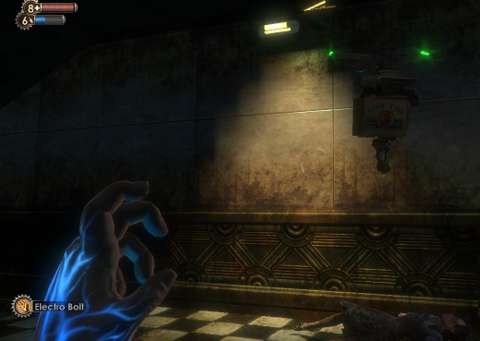
Then, there are hypnotized Big Daddies, which become available if the player picks the “rescue” path and sticks to it. It may be tempting to have a Big Daddy follow the player around, but he is even more obstructive than hacked security drones. Furthermore, any stray shot from the player which hits the Big Daddy immediately turns him hostile.
This is a major caveat which the player has to consider if he/she wants to go down the “rescue” path.
CHARACTER DESIGNS – AND LOTS OF RADIO & AUDIO PLAYBACKS:
Some of the greatest appeals of BioShock are its characters. However, a major catch has to be mentioned first: most of the characters’ nuances have to be listened to, and not watched.
Most of the time, the player will be listening to these characters over the radio as they send what are practically one-way messages to the player. They will mention their opinions of what is happening at Rapture, make remarks about the player’s decisions and reveal their own motivations, but they never seem to ask for the protagonist’s opinions.
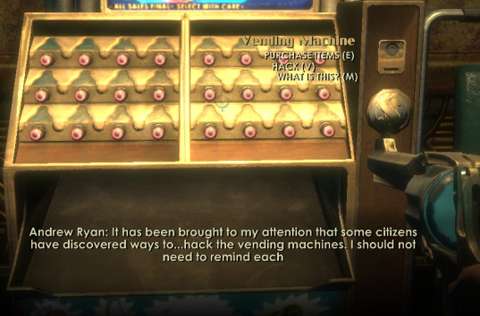
Then there are the “audio diaries”, which are the recordings that characters make when they muse over what is happening in Rapture and over what they and other people have done.
These audio disclosures will be interesting to players who want to know more about Rapture and its backstory. Players who do not bother to listen to them are still made to listen to distilled descriptions of the characters, usually through the remarks of whoever is guiding the player character at the time.
If the player is given actual visual depictions of these characters, it is usually through pre-scripted scenes, such as glimpses of characters seen through windows or around a faraway corner before they scamper out of sight.
For some characters, this culminates in them meeting the protagonist in person. This is done either through the boss fights, which are mostly disappointing as mentioned earlier, or through cutscenes of major plot twists. The latter are particularly impressionable, though it might also disappoint some players that these meetings are so brief.
Nevertheless, these plot twists are memorable, and this is what matters when the game is looked back at in hindsight.
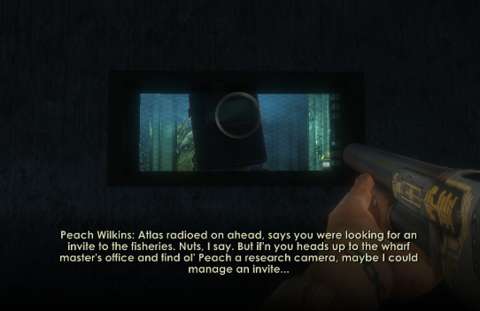
STORY & GAMEPLAY PROGRESSION:
During its time, BioShock was particularly notable for tying the progression of its story with the progression of its gameplay.
As mentioned earlier, the player character understandably starts unarmed. He eventually gets more equipment and capabilities, usually through story-related events. For example, the first choice which the player can make about the fate of a Little Sister is very memorable, especially considering that the mutant girl is cowering and gasping in fear.
However, some gameplay elements appear to have been introduced by exploiting the whimsical insanity and vague remarks of the characters. For example, Peach Wilkins wants photos of Spiders Splicers. People who give this part of the story the benefit of the doubt will say that these photos can grant him research benefits, but the narrative is not clear about whether the photos or the camera grant these.
With these examples mentioned, it has to be said here that as far-fetched as a gameplay element seems with regards to the narrative, there is always a counter-argument in support of it. Sure, to those who are skeptical, it may seem like a lot of benefit of the doubt, but it can never be truly shot down.
There are a few notable hiccups in how the story affects the gameplay though. For example, there is the scenario where a certain character asks the player character to surrender his guns. The player must have him do so in order to progress.
The problem is that when the player character retrieves his guns, his ammo is not returned to him. Most of it is gone, including even the special ammunition. This bug has never been fixed even to this day.
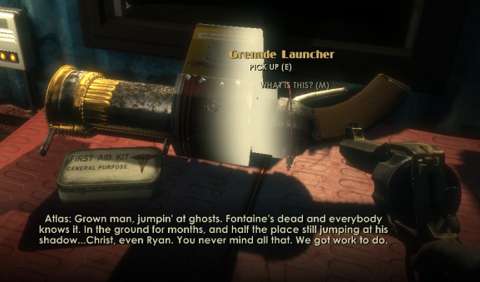
ENVIRONMENT ARTSTYLE:
BioShock makes its sources of artistic inspiration known early on. There are a lot of elements of art deco, mixed in with steampunk and retrotronics. The pervasiveness of liquor also gives a vibe of speakeasy. It is worth noting here that few other games had such blend of visual designs at the time.
Still, there is the impression of the “city of the future” trope. After all, Rapture is obviously technologically advanced; its many mechanical doors suggest such an impression. Indeed, this would have made the game seem typical and done-before, if not for the obvious run-down status of Rapture.
Speaking of which, the game always takes the opportunity to give the impression that Rapture has seen better days. There are many scenes which depict Rapture’s splendidly curvaceous architecture, but these scenes are marred with crumbling decay and moldering refuse.
SHADOWS:
BioShock makes use of very deep shadows, even for an Unreal engine game. This was deliberate, because the game’s designers wanted the darkness to contribute to Rapture’s foreboding atmosphere. The shadows happen to achieve this goal.
However, they do happen to make models more difficult to look at. Splicers, in particular, have facial features which feature so much normal-mapping that their faces are near-impossible to see most of the time. (On the other hand, the splicers do look very hideous.)
CONVINCINGLY UNPLEASANT MODELS:
No one at Rapture is a looker. The Splicers have hideous mutations. The Little Sisters just can never pass as sweet little girls. The Big Daddies look intimidating and unapproachable. All machines look like they are cobbled together using hastily designed blueprints (which they likely are).
All of these visuals are intended by the game’s developers and its creator Ken Levine, for both narrative reasons and, again, projection of a foreboding atmosphere.
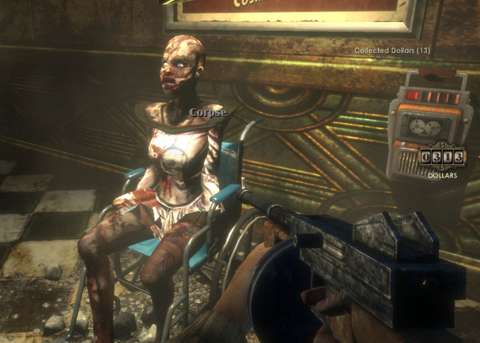
GOLDEN SHEEN ON OBJECTIVES:
For whatever reason, objects which the player character needs to interact with have shaders which give them golden glimmers and sparkles. This makes them stand out, which is just as well. They do clash with the rest of the aesthetics of the game, but there is a narrative reason for this (albeit implied).
SOME WHIMSICAL MODELS:
There are some models which have been made but not used in meaningful ways in the game. For example, there are models of cats which can be found in some nooks and crannies, but they are for dead cats. There are narrative excuses for the presence of cats in Rapture, but one would have expected to see some living ones. There are not any; somehow, Rapture can kill even these resourceful felines.
This is just a minor complaint of course, but one would think that the game could have had a more efficient installation size if there was not any of these extraneous models.
RECYCLED MODELS:
As mentioned earlier, the game makes use of recycled models for the bosses. There are also some major characters who have been given recycled models, such as Atlas, with the excuse being that the player will not come close enough to see these characters. This can give an impression of laziness on the part of the game’s model designers.
WATER RIPPLE EFFECTS & PROBLEM:
Even back in 2007, the Unreal engine was vaunted for being able to create believable visuals, such as the undulating sheen of water surfaces.
One would think that BioShock would have benefited from this, considering that the game has so much water. However, the visual effect becomes a problem when there are supplies or corpses submerged under shallow water.
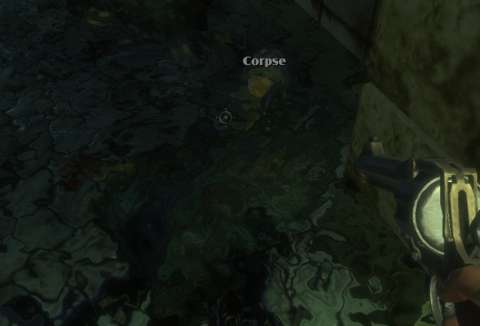
It does not affect the tool-tip which appears when the player is looking at a submerged object, but it does obscure the shining effect which loose objects have.
TEXTURES & NORMAL-MAPPING FAILING TO LOAD:
There are occasions where the textures and normal-mapping for models fail to load. For example, it may occur when the protagonist brandishes the ADAM sea slug after harvesting a Little Sister. The sea slug is supposed to be an impressively hideous thing, but if its textures and normal mapping fail to load, it looks like a living piece of human intestine.
SOUND DESIGNS – IN GENERAL:
Most of the sound designs in BioShock have been designed such that they fulfill gameplay, thematic and atmospheric purposes, often all at the same time. There will be elaboration on this statement shortly.
VOICE-OVERS:
The best sounds to be heard in BioShock are the voice-overs. Most, if not all of them, are quite well-done. The main characters that are Andrew Ryan, Atlas, Tenenbaum and Frank Fontaine have voice-overs which are especially memorable.
For example, Atlas’s voice-overs have been noted by some real Irish persons (such as GameSpot’s Danny O’Dwyer) to have a convincing working-class Dublin Irish accent. (Ironically, within the story of BioShock, the accent turns out to be faked.)
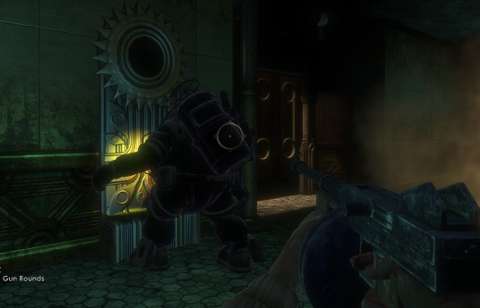
The other characters might be less notable, but there are rare few cases where the voice-overs are not entertaining to listen to. More importantly, they reveal a lot of the backstory about how Rapture fell apart.
AMBIENCE:
Ambient noises are the next-most prominent sounds in the game. There is a lot of mechanical creaking and yawning to be heard throughout Rapture, suggesting that Rapture is succumbing to undersea pressure. There is also plenty of water dripping to be heard, of course.
Then there are sounds of steam-belching and hydraulic machinery, which are of course expressions of the game’s steampunk influences. Next, there are the bleeps and tinkling of Rapture’s retrotronic devices. These greatly contribute to the game’s aesthetics.
SOUND EFFECTS:
Being a shooter, BioShock has plenty of gunfire to be heard, along with the usual noises of bullets ricocheting off surfaces and concrete cracking under the impact of shots. There is also a lot of splashing to be heard when combat occurs in partially flooded places.
There are also audio cues, such as the unsettling noise and heartbeats which play when the player character is close to death.
However, sometimes, the game may fail to play specific sound clips. This tends to happen if there are a lot of things occurring on-screen. For example, in heated firefights with security apparatus (if for whatever reason the player actually gets caught by them), the noises of their motors tend not to be played.
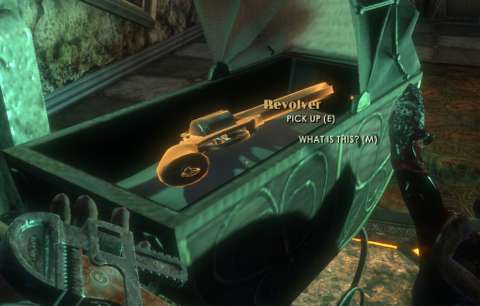
MUSIC:
Although there are lot of tunes and melodies to be heard, they are often used for purposes other than music tracks. Rather, music is often only heard in the cutscenes. This is not a poor choice of presentation; rather, the music does accentuate the brevity of the cutscenes.
CONCLUSION:
Usually, hindsight is not kind on games which obtained accolades when they debuted; once the bias of hype has gone away, the glamour of a game thought excellent goes away too. However, this will not be the case if a game has aged well, e.g. few other games could do what it has done.
BioShock is one such exception. Not a single one of its gameplay elements were new, but the way in which they were brought together was quite refreshing. Even up until now, few other games can throw so many elements in and still deliver functional gameplay and engrossing story.
Unfortunately, there are too many minor problems to gloss over. There are recycled models, hiccups with the Unreal engine and issues in how some gameplay elements mesh with the story, to cite a few examples of these. Yet, overall, the game’s designs are still of high caliber.
